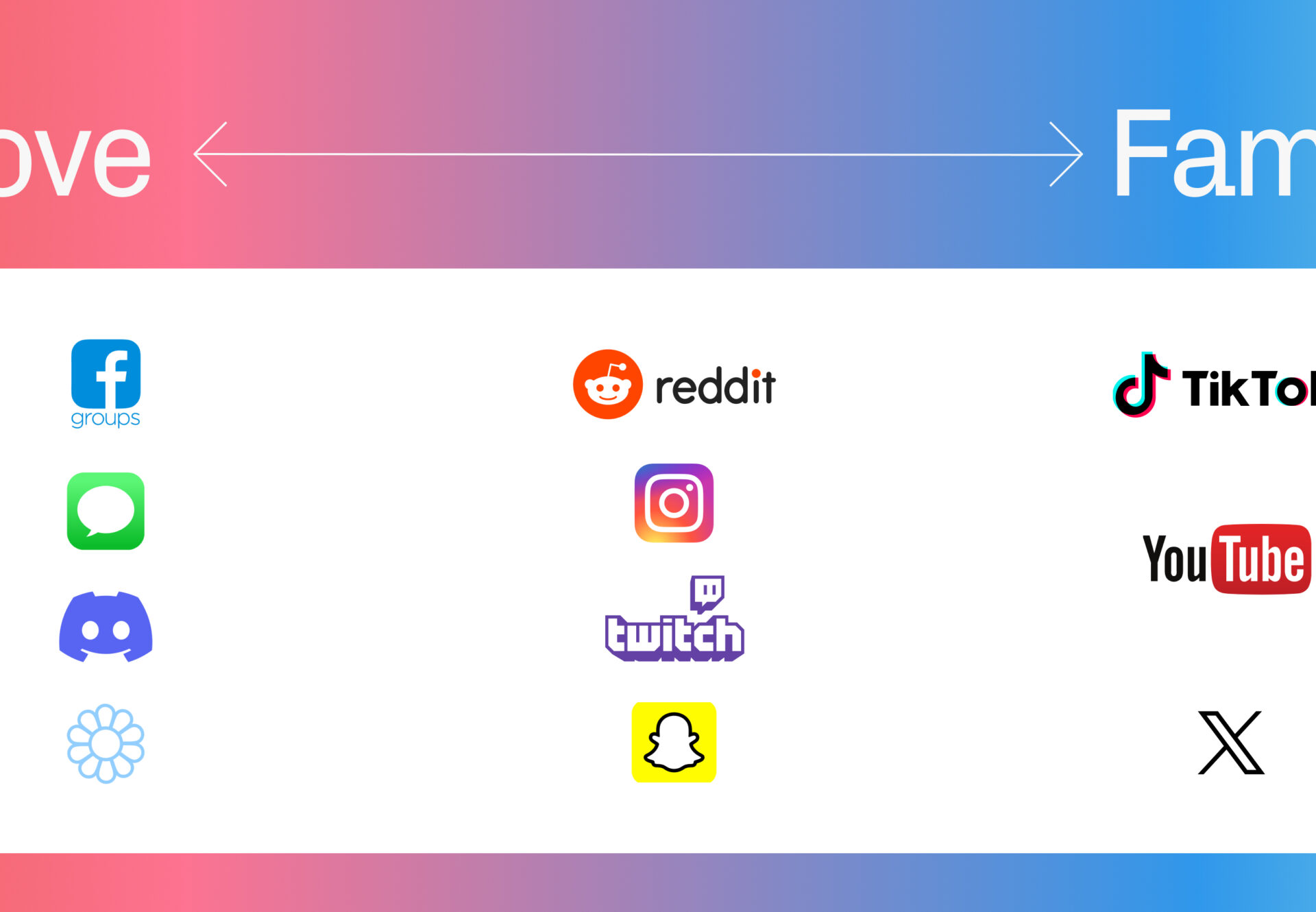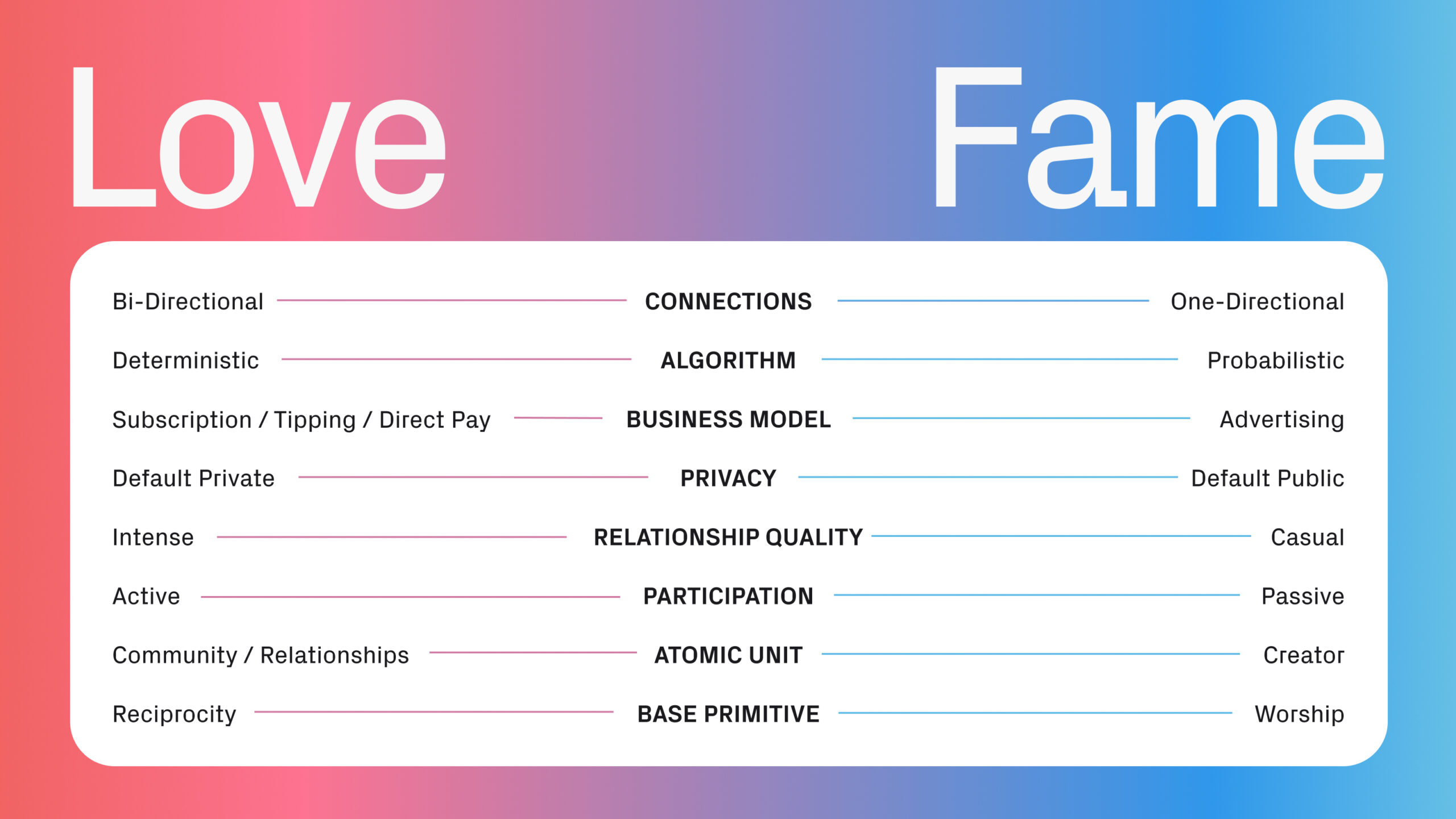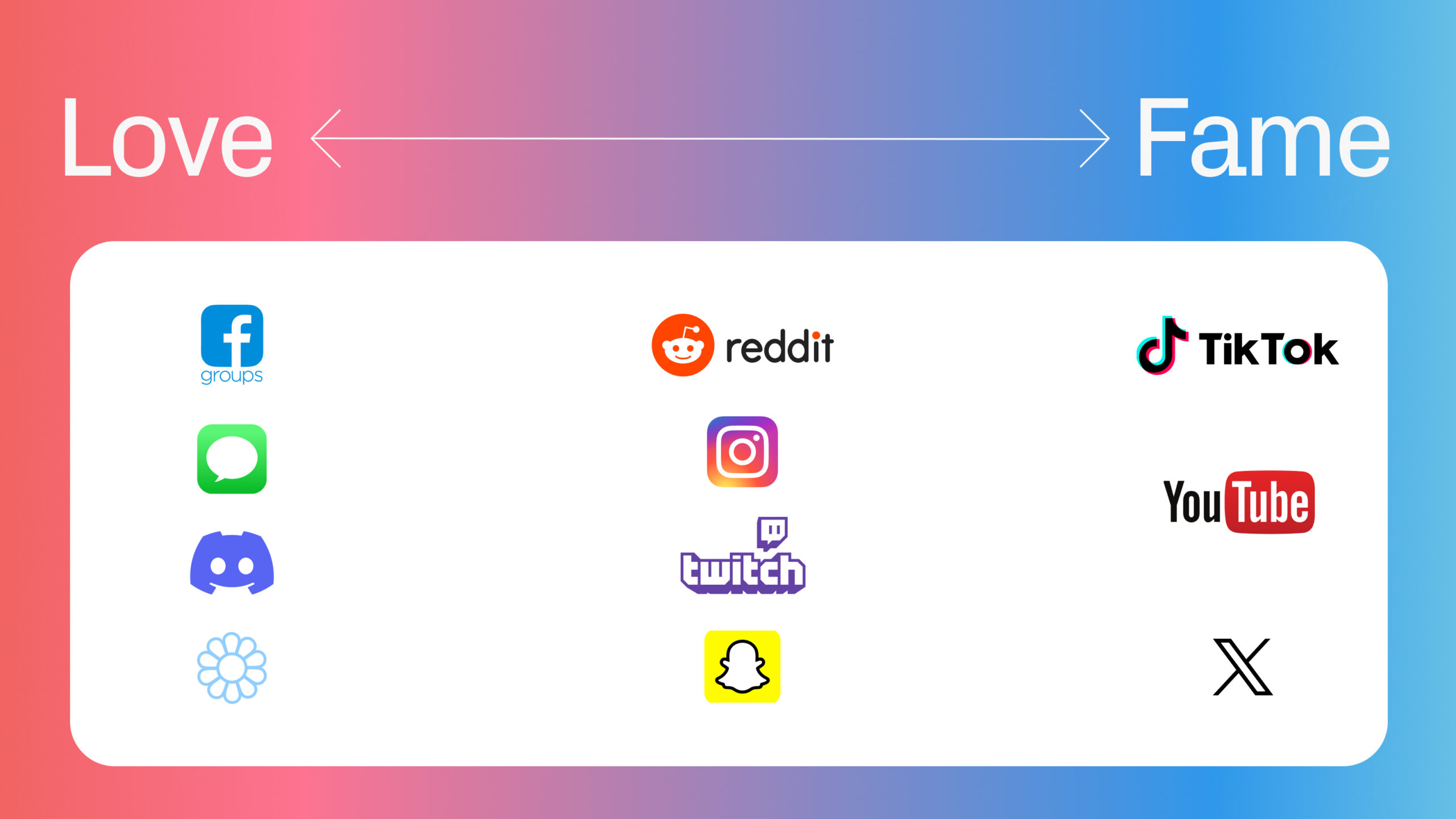Li Jin

Love vs. Fame: A Framework for Social Applications
While “social” is often generalized as a single monolithic category, there’s actually a ton of variance in today’s landscape of social apps.
An axis on which I like to analyze social networks is how much they appeal to love vs. fame.
Years ago, Kevin Lin, the co-founder of Twitch, told me that there are three dimensions on which Twitch offers value to creators: love, fame, and money. (There’s a YouTube clip of Emmett Shear, another Twitch co-founder, outlining this framework.) For the purpose of this post, I’ll put money—or the prospect of earnings—aside, since that’s an orthogonal dimension that I’ll unpack later.
All social networking apps fall on a spectrum from love to fame.
On the love side of the spectrum are products that focus on deepening connections with others. Examples are iMessage, Whatsapp, early Facebook, and Discord. The value proposition is connecting more intentionally with others, cultivating existing relationships, and intensifying affinity. These products are often marked by bidirectional relationships, like friendships on Facebook or iMessage. When users use a product like Discord or Whatsapp, they usually do so for a particular community or person—not to discover new content. These products reinforce this value proposition by featuring a deterministic algorithm (if person A sends something to person B, the other person will always receive it).
On the fame side of the spectrum are products that help users get exactly that: fame or reach. These products are built around discovery of new content and creators. Examples of fame-centered social products include YouTube, Instagram, TikTok, and Twitch. These products feature one-directional relationships (or “followers”). Influential users professionalize, becoming creators and reaching ever-larger audiences—a dynamic that’s not present on bidirectional social networks. Products on this side of the spectrum feature probabilistic algorithms, where content gets shown depending on likelihood of engagement, so users aren’t guaranteed to reach their followers.
The dichotomy between these two ends of the spectrum could be summed up as social networking vs. social media.
There’s an inherent tension in building for love vs. fame, rooted in the zero-sum nature of time and attention: users only have a limited amount of time to spend on any one social app, so the apps that emphasize new content discovery from creators over engagement with content from existing connections are by definition catering to fame more than love.
An example here is TikTok’s default For You feed: it underweights the follower graph and instead defaults to showing users new content.
The love vs. fame dichotomy is a spectrum; platforms often feature elements that cater to both love and fame. Instagram—which over time has trended toward fame as a whole—has both fame features (Explore, Reels) and love features (DMs, Stories, Close Friends). Reddit’s home page can be browsed as a fame product, surfacing content across Reddit, but users who use the platform for specific subreddits, with mutual affinity among those community members, are using it as a love product. A mix of both types of features creates higher retention because there isn’t enough inventory of engaging love content. WhatsApp, Messenger, and iMessage have remained pure love utilities because of their network effects, but other social apps have all had to add fame features to increase retention.
A broader trend toward ‘fame’ products
I often hear people say they feel that, on a broader level, social networking is moving toward social media; apps that once focused on friends now focus on entertainment, and everyone is expected to be a creator now. Instagram, once used for keeping up with friends’ lives, is now used in large part to follow creators and brands.
I think there’s truth to this, and it’s guided by business models and incentives rooted in network effects. Social networks featuring bidirectional social graphs hit a ceiling of network effects once users reach the limit of who they know. The utility of a product like iMessage or the original Facebook doesn’t scale as the total user base grows. Instead, it reaches a ceiling once users have connected with all of their friends. However, fame-based products have more uncapped network effects: users can be shown content from anyone, and utility continues to improve as more users join. Under the dominant business model of advertising, keeping more users engaged for more time is the north star goal, and the fame-driven model is more advantageous for scaling users’ attention—and revenue.
It’s interesting to note that social products on the love side of the spectrum generally don’t monetize well through ads: users understandably don’t want ads inserted in the middle of their messages to friends, or in smaller communities. Instead, the dominant business model of love products tends to be user subscription, whether to the platform (e.g. Discord Nitro, or WhatsApp’s original $1/year fee) or to specific creators or communities (Twitch subscriptions). This is even more true with dating apps, where price points for subscriptions to Hinge, Bumble, and Tinder are even higher. People are willing to pay more for more serious relationships and connections.
Successful fame platforms also feature a core skill-based status game, as Eugene Wei described in his post on status as a service. By contrast, that status game is less prominent in love products, confined to smaller networks. Many love-based social products are more like feature-rich communication utilities, versus platforms to pursue social status. They serve a utility in users’ lives, connecting them to friends or groups, versus being the site of performance. Obviously, some products introduce a status game into love platforms—imagine up/downvotes on Reddit posts—but the status game is usually smaller in nature.
The meaningful vibe shift on X, which many users have remarked on, is indicative of a shift from a love platform to a fame-focused one. While the default news feed previously prioritized tweets from accounts you followed, the new algorithm is full of people you don’t follow. The new default “For You” feed (a nod to TikTok) shows viral posts that the algorithm has determined—based on probability of engagement—you might enjoy. Analyses of its open-sourced algorithm have also revealed that X Premium (formerly Twitter Blue) subscribers are given a boost in the feed ranking. This design, which underweights the follower graph that users had curated over time in favor of a more engagement-oriented and recommendation-based model, has meaningfully changed the tenor of the platform; it’s shifted it from a composite of deliberately chosen creators to a much more viral, hits-driven platform.
i can’t really describe what’s changed but twitter used to be a hotbed of really great intellectual discussion from small and interesting accounts that I respected and now it seems to be a zombie TL promoting random videos and meme content
— roon (@tszzl) October 5, 2023
The tendency to shift toward fame, as we’re seeing in mature social networks, creates an opening for new networks that focus on deepening connections. There’s room for love-based products to serve smaller communities and groups, particularly as incumbents beholden to an advertising-based business model seek ever-increasing user attention to grow their businesses.
Newer social media apps usually focus on an initial wedge use case for smaller groups. Apps like BeReal, Retro, and Lapse each put their own spin on fostering deeper connections with friends that fame-based social media leave behind (with varying degrees of enduring success). But apps focused on smaller use cases often struggle with monetization and can become victims of their own success, eroding their value proposition of connecting deeply with smaller groups as they grow and as the novelty wears off.
Crypto social
To date, crypto social has been largely about love (helping users form deeper connections) rather than fame. In contrast to web2, where the ad-based business model exerts pressure to trend towards social media and entertainment products, crypto uniquely makes it possible for love-based networks to thrive. I’ve previously written:
A crypto social network can enable smaller, high-context groups to flourish, through new business models that make their existence possible. Today, the north star goal of most web2 social platforms is to grow at all costs, which aligns with their business model of advertising. That means products focused on smaller groups, like Facebook Groups or Twitter Communities or the now-defunct Path, don’t have great business models.
Crypto could change this, by enabling those smaller communities to viably exist and flourish. That could take the form of having shared treasuries (Nouns DAO or FWB) and creating alignment toward maintaining the health of the community, or minting onchain artifacts of their community as a means of generating revenue (like Crypto, Culture & Society DAO, a learning community).
A few years ago, Facebook piloted a feature to let group admins charge an admission/membership fee to support the cost of moderating and maintaining their communities (for many, a full-time job). For some reason, that feature was sunsetted, and FB Groups remains under-monetized. I think there is user willingness to pay to support smaller, healthier communities, but limited infrastructure to enable that. With crypto, these communities can more easily choose and configure their own business models, and with that, we could see a flourishing of smaller communities.
Zooming out, the biggest outcomes in social have historically arisen from the creation of new networks: from IRL friend-based networks (Facebook) to interest-based ones (Reddit, TikTok) to knowledge-based (Quora). There’s an opportunity for crypto to take a crack at building a new type of ownership-based network that leverages onchain assets as the basis for new communities. We refer to this idea as a socioeconomic network (versus a purely social network).
These communities could deepen connections between users based on shared ownership, helping them find their tribe. In the real world, shared ownership often serves as the foundation for connection, from neighbors to coworkers at a startup. DAOs and NFTs are early examples of communities wherein shared onchain ownership forms the basis for high-affinity communities. In August 2023 alone, 94.5 million NFTs were minted across Ethereum and L2s; as the volume of user activity grows, you can imagine inferring users’ interests based on onchain actions and exposing connections based on rich activity history.
Fame and reach is a tricky value proposition in crypto since there are only about 400,000 daily active wallets on Ethereum. At the same time, that number is growing steadily—and is now substantial enough that discovery-focused platforms, especially those that monetize through a model other than advertising, can be built. To build a sticky social product that appeals to fame, tapping into user psychology—and the desire for social status—is critical. That means introducing a new skill-based game.
Skill-based games in crypto often focus on the highest earners, spenders, or something financial in nature. For instance, Friend.tech’s leaderboard could be seen as a status game in which the ranking is based on the highest key price, i.e. the number of holders one has. I think money-based status games are inherently exclusionary—they advantage those with more capital and are intimidating for newcomers. Consider that a new user to TikTok likely feels like they can win at the app’s core status game of creative videos, but a newcomer to a financialized social network may feel like the odds are stacked against them.
A new type of status game that crypto could offer, with lower barriers to entry, is “proof-of-first”: who first did something, discovered someone, or minted something first, based on onchain activities.
An example of this is Sound.xyz’s “Earliest” view on every user’s profile, which showcases the artists they were earliest to back. This type of behavior has precedent in web2, where users like to comment “first” or “early” or “investing at [#] likes” on a piece of content to signal that they were early to discover it. On a crypto social app where user actions are timestamped onchain, such “proof of first” could be not just user-generated, but surfaced in a more automated way, with gamification around it.
As mature social networks trend more towards fame, there’s room for new networks to focus on deepening connections among communities. Crypto’s unique characteristics create opportunities for new networks along the entire love-fame spectrum to flourish as users connect on shared ownership and interests. I believe new business models will emerge to support different and smaller networks than what can viably exist under ad-based models, fulfilling humans’ need for social status and connection in novel ways.
Thank you to Eugene Wei, Ravi Mehta, Tom Verrilli, Willem Simons, and Si Jia Wen for their feedback.
+++
This post is for general information purposes only. It does not constitute investment advice or a recommendation or solicitation to buy or sell any investment and should not be used in the evaluation of the merits of making any investment decision. It should not be relied upon for accounting, legal or tax advice or investment recommendations. You should consult your own advisers as to legal, business, tax, and other related matters concerning any investment. Certain information contained in here has been obtained from third-party sources, including from portfolio companies of funds managed by Variant. While taken from sources believed to be reliable, Variant has not independently verified such information. Variant makes no representations about the enduring accuracy of the information or its appropriateness for a given situation. This post reflects the current opinions of the authors and is not made on behalf of Variant or its Clients and does not necessarily reflect the opinions of Variant, its General Partners, its affiliates, advisors or individuals associated with Variant. The opinions reflected herein are subject to change without being updated.
Variant is an investor in Sound.


